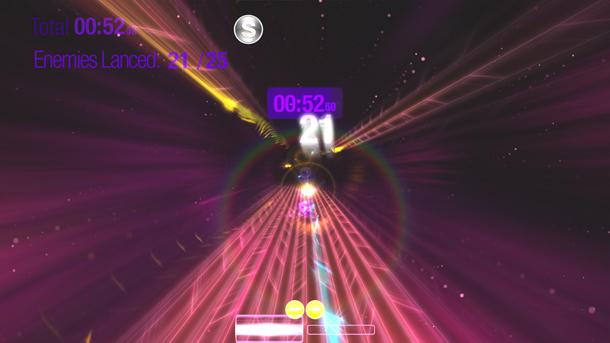If I had to describe Dyad to someone who had never played a video game, I’d probably sound a bit like a lunatic. When a dedicated gamer tries to explain it to another, it might be a little easier to digest, right?
“So, what do you think of that Dyad game?”
“It’s pretty crazy.”
“What’s it like?”
“It’s… pretty crazy.”
Those words were spoken between two PAX East attendees waiting in line in front of me at the food court. I hadn’t made it to the Indie Mega Booth yet, so my expectations for the game were non existent. That exchange, however, did much to prepare me for what the game was actually like: pretty effin’ crazy.
Dyad, the new game from Shawn McGrath and his ][ Games Studio, is perhaps easily conveyed through the idea of traveling through a hyper-space light tunnel. The vantage point leads me right into the tv screen set up into the table in front of me, as if I was about to emerge in a TARDIS on the other side. All around the “tunnel” are markers, enemies, and mines, displayed by different shapes and colors. As I advance through the tunnel, I’m asked to either hook onto the shapes, skim alongside them, or try to avoid them completely.
Then things get bonkers.

The more that I hook onto the shapes and perform combinations, the more that the game speeds up. The more that the game speed changes, the more moves that I’m able to pull off, creating more combinations and altering the speed further. Things begin to move in and out of the screen, colors and lights explode at an increasingly epileptic pace, and the tunnel requires quicker rotations and hair-trigger button presses to achieve the growing combos. The atmosphere moves from spectacle to chaos, and a small crowd draws behind me as the game progresses, even when going through a few abrupt stops when I miss a combo.
Being a score-based game, there’s no way to lose in Dyad. There are only better medals to earn each time, or a higher score or more combos to put together. This lets me worry less about my end performance, keeping me focused on the instantaneous goal at hand.
“It’s pretty crazy.”
It may seem hectic to a bystander, or even unplayable. Everything on the screen moves so incredibly fast that unless I’m playing the game I can’t follow along. But it works — and it works extremely well — because of the music. The audio track, and the tune that I create as I hit or miss combos, skimming along or hooking onto markers, creates a rhythmic beat that my fingers anticipate as I play. By the completion of that short, two stage demo, I felt as if I could play with my eyes closed, just listening to the music as my hands melted into the controller.
I’m curious to see how much deeper down the audio/visual rabbit hole Dyad can actually take us. If its designer chaos can hover just below the overwhelming threshold, there may be a chance for an existential experience… or at least one that college kids can leave on in the background to replace the lava lamps and blacklight posters.
Images & video courtesy Shawn McGrath and ][ Games

No Comments